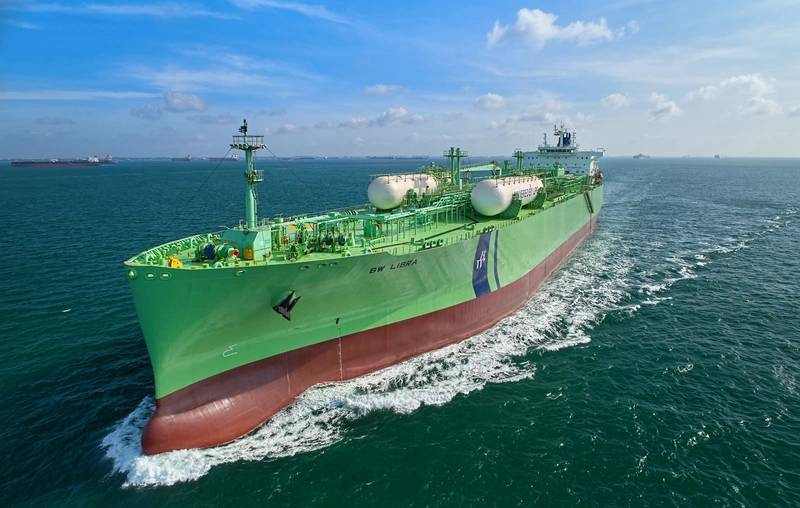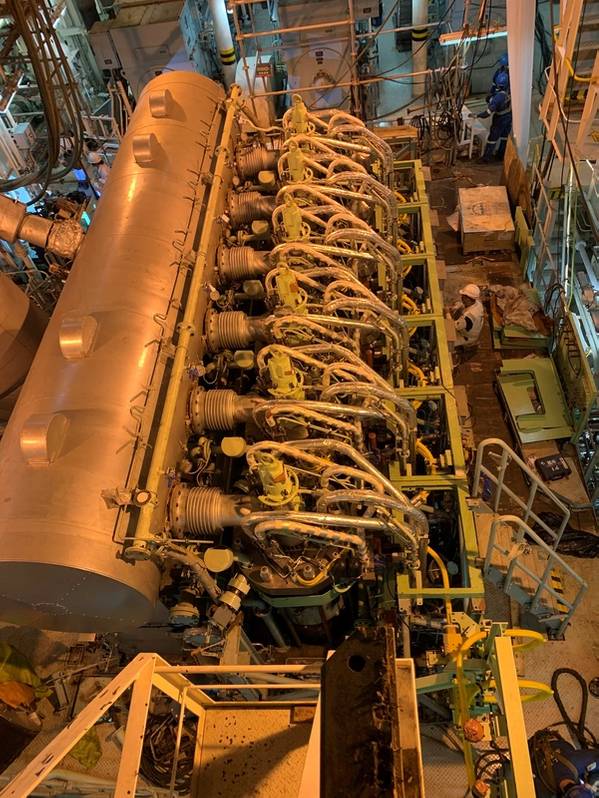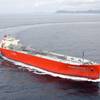LPG: Dual-Fuel Engines Prove Their Worth
BW LPG has demonstrated the value of dual-fuel LPG operations beyond the company’s initial aim of meeting IMO 2020 Sulphur Cap regulations.
In October 2020, the LPG carrier BW Gemini became the first very large gas carrier (VLGC) to have its low-speed main engine converted to an LPG dual-fuel engine. The project started several years earlier, sparked by Oslo-listed BW LPG’s preparations for the IMO’s 2020 Sulphur Cap regulations.
Compared to heavy fuel oil, LPG reduces Sox emissions by approximately 97%, particulate matter by approximately 90%, CO2 by approximately 15% and NOx by approximately 20%.
The world’s largest owner and operator of VLGCs, BW LPG’s fleet has a total carrying capacity of over three million cubic meters, and the company recognized the advantages of retrofitting rather than replacing tonnage. CO2 emissions are around 95–97% less for a retrofit than building a new ship, and retrofitting takes two months compared to two years for a newbuilding.
- Engine Technology
MAN Energy Solutions provided the engine technology, and Klaus Dahmcke Rasmussen, Head of Projects and PVU Sales at MAN PrimeServ, said that by leveraging LPG as a marine fuel, vessels benefit from savings due to lower fuel consumption and full dual-fuel flexibility which guards against sensitivity to post-2020 fuel-price fluctuations. The ability to use LPG cargo as a supplemental fuel source also reduces time and bunker fees.
In June 2022, under MAN PrimeServ’s supervision, the conversion of the main engine of the BW Malacca to dual-fuel was completed at Yiu Lian Dockyards in Shenzhen, marking the last of a series of 15 such retrofits for BW LPG. During the vessel’s five-year drydocking, the ship’s MAN B&W 6G60ME-C9.2 type engine was retrofitted to an MAN B&W 6G60ME-C9.5-LGIP capable of operating on fuel oil and LPG.
MAN claims its B&W ME-LGIP is the world’s first and only dual fuel engine with liquid gas injection that allows switching between conventional HFO, MGO, and LPG fuels without any loss of performance or efficiency. The modular design principle of its ME-C engines allows simple conversions to LGIP, says Rasmussen.
“As an additional feature, the LPG engine has great potential for being a solution to handle the volatile organic compound (VOC) issue in shuttle tankers and other crude oil carriers. This is because the engine features innovative options for burning the liquid VOC. The engine can burn any mixture of propane and butane, and furthermore, the mixture can contain significant amounts of ethane. All heavier hydrocarbons normally contained in the liquid VOC can be used as well.”
 BW Libra at Singapore Fairway. Image courtesy BW LPG
BW Libra at Singapore Fairway. Image courtesy BW LPG
- Safety Considerations
LPG doesn't take more space than LNG, and it's simpler to handle because it doesn't require cryogenic storage. As LPG propulsion on large two-stroke diesel engines was a pioneering technology, safety was understandably a priority concern. LPG had not previously been allowed in the engine room prior to the trial of LPG propulsion technology. This was largely due to the nature of LPG – being heavier than air, it flows downward and remains near the bottom and in spaces where it can be a safety issue.
To manage this concern, extra detectors and double-walled fuel pipes were installed. If hydrocarbons are detected, the supply flow is automatically shut down and immediately switched to compliant fuel, which is always available as a standby. With these robust safety measures, BW LPG successfully secured regulatory changes from class and flag to accept and approve the use of LPG in the engine room.
- Performance
The investment cost for the retrofits was around $8–9 million per ship, and 2022 was the first year all 15 VLGCs were sailing. LPG has proven to be 10-12% more efficient compared to diesel or heavy fuel oil on BW LPG’s ships. Even if the company hadn’t been prompted by the IMO 2020 sulfur cap, converting to LPG would still have made financial sense.
Prodyut Banerjee, Vice President and Head of Operations at BW LPG, says: “We have been systematically scaling up our intake of LPG as fuel to maximize emissions reduction, and maximize earnings by reducing the cost of fuel.” He adds, “Our engineers are also honing their expertise in dual-fuel engine management.”
In 2022, the 15 LPG-powered vessels bunkered approximately 46,000 metric tons of LPG, saving about $7.4 million in fuel costs. BW LPG also reduced carbon emissions by approximately 27,000 MT by using LPG as fuel. This translated to an approximate 15% reduction in CO2 emissions. Added to that was a 99% reduction in SOx emissions and a 10% reduction in NOx emissions.
“It has now been over a year since all 15 of our retrofitted vessels are on water. We also welcomed a dual-fuel newbuilding to our pool fleet recently. We continue to keep our focus on flawless operations and to maximize the environmental, economic and operational benefits of LPG propulsion,” said Banerjee. “Our vessels are sailing at peak service levels and are fulfilling all commercial obligations, and we are always looking to optimize our LPG fuel usage based on best operational outcomes for each voyage.
“Moving forward, and with an eye on new environmental regulations, these LPG-powered vessels will be able to maintain maximum service speeds for the foreseeable future. We will continue to harness the benefits of using LPG as a transition fuel, reducing our emissions and benefiting from better economics.” BW Gemini at Enterprise Terminal. Image courtesy BW LPG
BW Gemini at Enterprise Terminal. Image courtesy BW LPG
- More Orders
BW LPG is not the only shipowner benefiting from LPG propulsion technology. In January 2023, COSCO Shipping Heavy Industry (Guangdong) announced that it will retrofit the main engines on two LPG carriers operated by Tianjin Southwest Maritime. In doing so, it is exercising the option in a contract signed with MAN PrimeServ in October 2022 to retrofit two other LPG carriers.
The individual MAN B&W 6G60ME-C engines on Gas Libra and Gas Scorpio will be retrofitted to dual-fuel MAN B&W 6G60ME-LGIP engines when they enter drydock in January 2024.
MAN Energy Solutions reports that ME-LGIP engines have now surpassed 120 orders, with 35 already in service. Most of the current orders for LPG carriers over 30,000cbm include ME-LGIP technology, enabling these vessels to use their own cargo as fuel. Rasmussen says LPG is quickly becoming the de facto standard in this segment. “Currently, we estimate that there are over 150 VLGCs with single-fuel engine technology that could benefit from conversion to LPG-running.”
BW LPG is now looking further into the future and exploring alternative fuels such as ammonia, as it’s a good hydrogen carrier and a zero-carbon fuel. The company is looking at it closely and dedicating resources to exploring ammonia as marine fuel with equipment suppliers such as MAN.
 MAN B&W 6G60ME-C9.2 type engine was retrofitted to an MAN B&W 6G60ME-C9.5-LGIP dual-fuel type capable of operating on fuel oil and LPG. Image courtesy of MAN Energy Solutions
MAN B&W 6G60ME-C9.2 type engine was retrofitted to an MAN B&W 6G60ME-C9.5-LGIP dual-fuel type capable of operating on fuel oil and LPG. Image courtesy of MAN Energy Solutions













